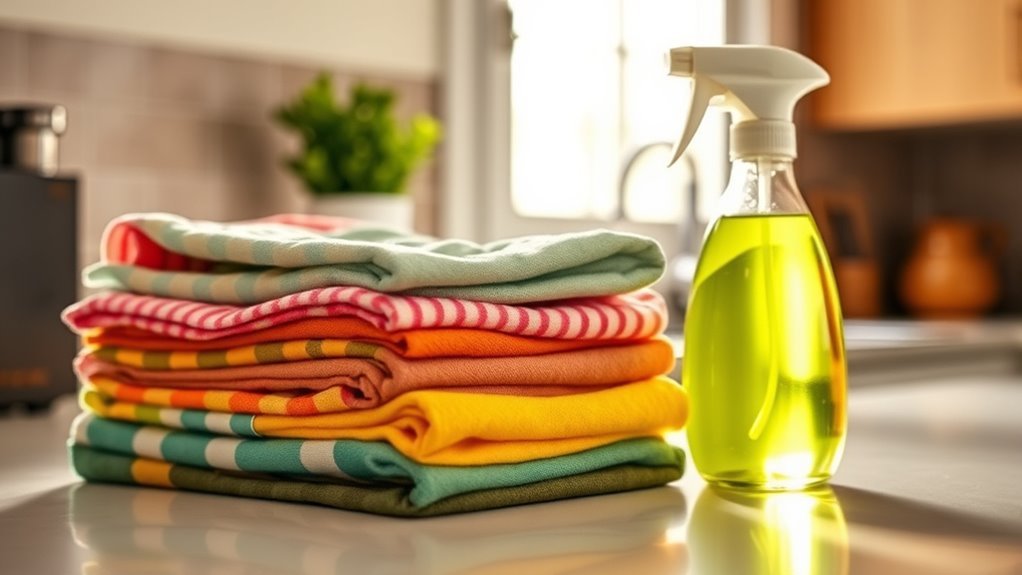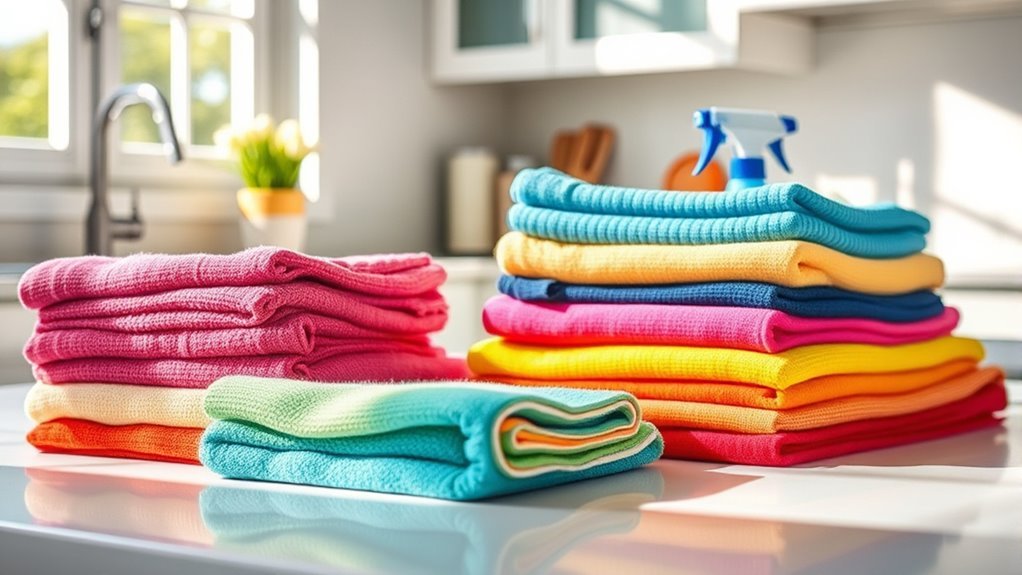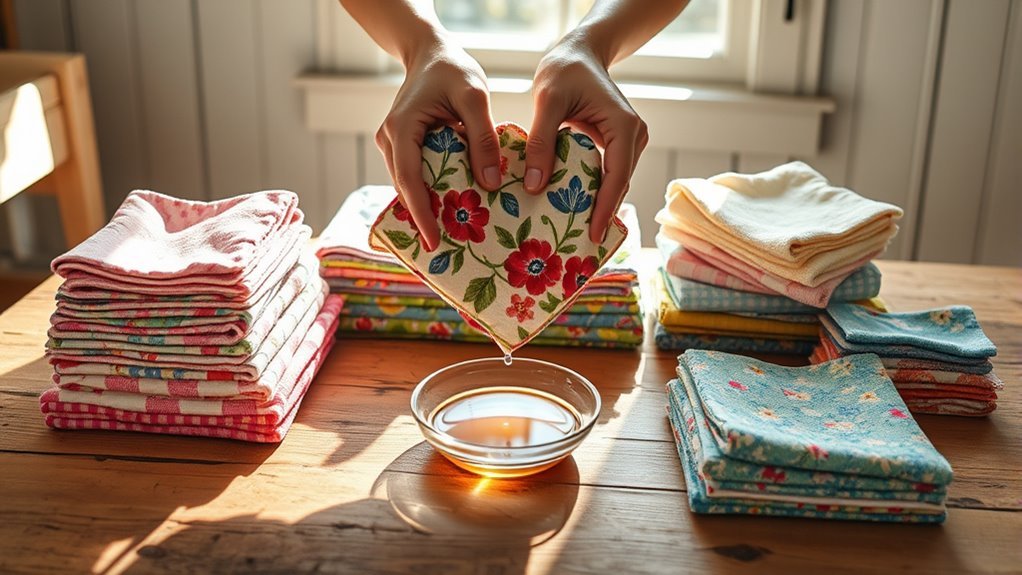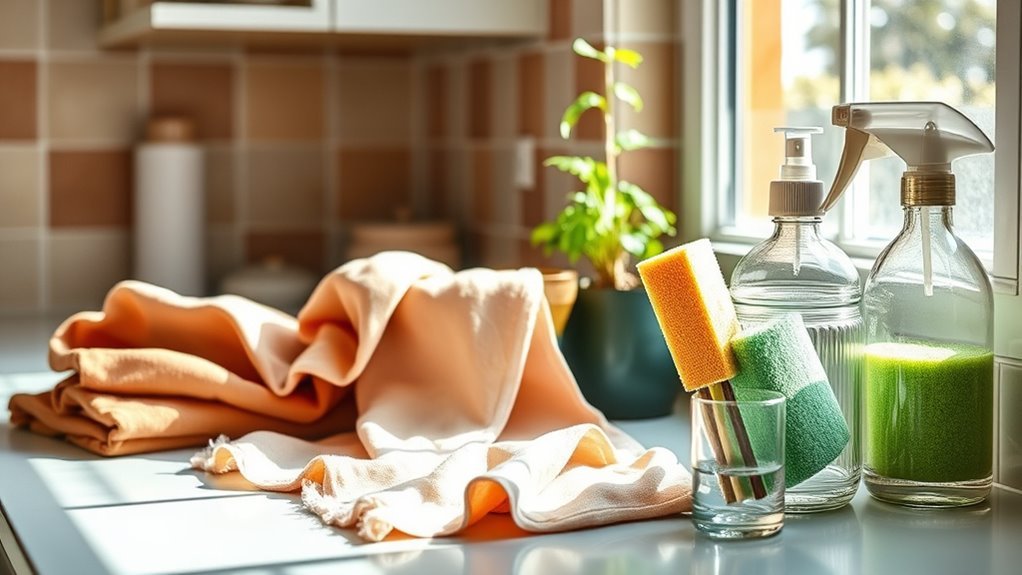Eco-Friendly Alternatives to Paper Towels for Cleaning
If you want to cut waste and save money, reusable cleaning cloths are a great alternative to paper towels. Bamboo towels are sustainable, naturally antibacterial, and soft, while microfiber cloths trap dirt effectively without harsh chemicals. You can even make your own from old fabrics like cotton. These eco-friendly options soak up spills better and last longer. Taking care of them properly keeps them in top shape. Keep exploring to find the best option for your cleaning needs.
Benefits of Using Reusable Cleaning Cloths

Using reusable cleaning cloths offers several advantages that can make your cleaning routine more efficient and eco-friendly. When you choose these cloths, you take control over reducing your environmental impact by cutting down on disposable waste. Unlike single-use paper towels, reusable cloths can be washed and reused countless times, freeing you from constantly buying replacements. This means you’ll save money in the long run, enjoying real cost savings without sacrificing cleanliness. Plus, using cloths empowers you to make a positive difference without complicating your life. You’re not just cleaning your home—you’re supporting sustainability and personal freedom. By incorporating reusable cloths into your routine, you limit waste and expenses, making your cleaning habits both smart and responsible.
Bamboo Towels as a Sustainable Option
Though you might not have considered bamboo towels before, they’re a highly sustainable alternative to traditional paper products. Bamboo sustainability is impressive because it grows quickly without pesticides or much water, making it an eco-friendly material that reduces environmental impact. When you switch to bamboo towels, you’re choosing reusable, durable options that cut down on waste and save trees. These towels are naturally antibacterial and absorbent, so you get effective cleaning without harsh chemicals. Plus, they’re soft and gentle, offering comfort while you clean. Embracing bamboo towels gives you freedom from disposable clutter and helps protect the planet. By opting for bamboo, you’re supporting a cleaner lifestyle that aligns with your values and commitment to eco-friendly materials.
Microfiber Cloths for Effective Cleaning

You’ll find microfiber cloths are great for cutting down on chemicals while still getting surfaces spotless. To keep them working well, it’s important to clean them properly and avoid fabric softeners. With the right care, these cloths can last a long time, making them a smart, eco-friendly choice.
Benefits of Microfiber Cloths
Microfiber cloths offer three key benefits that make them a smart choice for eco-friendly cleaning. First, they boost cleaning efficiency by trapping dirt and bacteria without harsh chemicals. Second, their durability means you’ll use fewer cloths, cutting waste. Third, they save water and energy since they often require just dampening, not soaking or heavy laundering.
| Benefit | Why It Matters |
|---|---|
| Superior cleaning | Picks up dust & germs effectively |
| Longevity | Reusable dozens of times |
| Eco-friendly | Reduces waste & chemical use |
| Saves resources | Uses less water & energy |
| Cost-effective | Less need to buy replacements |
Proper Cleaning Techniques
When you use microfiber cloths correctly, they can make your cleaning tasks quicker and more effective. To get the most out of them, start by dampening the cloth slightly; this helps lift dirt without harsh chemicals. For proper disinfecting techniques, use a cloth with a suitable disinfectant solution, allowing it to sit on the surface briefly before wiping. When tackling stubborn spots, focus on effective stain removal by gently scrubbing with the microfiber’s fine fibers—they trap and lift grime better than traditional cloths. Avoid over-saturating the cloth to prevent spreading dirt around. By mastering these simple steps, you’ll enjoy a cleaner space while reducing waste and embracing a more eco-friendly cleaning routine that frees you from disposable paper towels.
Maintenance and Longevity Tips
Although microfiber cloths are durable, proper care is essential to keep them effective over time. To maximize fabric longevity, wash them separately from other laundry using a mild detergent without fabric softeners or bleach, which can damage fibers. Air drying or using a low-heat setting preserves their structure better than high heat. Avoid using dryer sheets to maintain their absorbency and cleaning power. By following these eco friendly practices, you reduce waste and extend the life of your cloths, cutting down on replacements. Treat your microfiber cloths with care, and they’ll keep cleaning efficiently, saving you money and helping the planet. Embrace these simple maintenance tips to enjoy freedom from disposable paper towels while supporting sustainability every day.
DIY Cloth Alternatives From Old Fabrics

You can easily create your own cleaning cloths by repurposing old fabrics like cotton or flannel, which work best for different tasks. Start by cutting them into manageable sizes and sewing edges to prevent fraying. To keep them effective, make sure you wash and store them properly after each use.
Choosing Fabric Types
Selecting the right fabric is essential if you want your DIY cleaning cloths to be effective and long-lasting. Choosing materials like organic cotton or hemp fibers not only supports eco-friendliness but also offers durability and excellent absorbency. When picking fabrics, consider these three key points:
- Absorbency: Opt for natural fibers like organic cotton that soak up spills quickly, making your cleaning effortless.
- Durability: Hemp fibers are tough and resist wear, so your cloths last through many washes and heavy-duty scrubbing.
- Texture: Mix smooth and rough fabrics to tackle different cleaning tasks, from wiping delicate surfaces to scrubbing stubborn grime.
Cutting and Sewing Tips
When repurposing old fabrics into cleaning cloths, cutting and sewing them correctly can make all the difference in their effectiveness and durability. Start by choosing simple cutting techniques—straight cuts work best for uniform cloths that fit your cleaning needs. Use sharp scissors or a rotary cutter to guarantee clean edges and prevent fraying. For sewing, follow easy sewing patterns like straight or zigzag stitches; these secure edges and add strength without complicating the process. If you prefer no-sew options, try folding and tucking edges for a quick fix. Remember, the goal is freedom from waste and expense, so keep your methods straightforward and functional. With these cutting and sewing tips, you’ll create reusable cloths that last and help you ditch paper towels for good.
Care and Maintenance
Once you’ve crafted your cleaning cloths from old fabrics, keeping them in good shape guarantees they stay effective and last longer. To maintain your DIY cloth alternatives, follow these simple steps:
- Wash your cloths regularly using eco friendly detergents that are gentle on both fabric and the planet.
- Dry them thoroughly before storing to prevent mildew and odors; opt for sustainable storage solutions like breathable baskets or cloth bags.
- Rotate your cloths to evenly distribute wear and avoid overusing a single piece.
Comparing Absorbency and Durability of Eco-Friendly Options
Although eco-friendly cleaning options are gaining popularity, you might wonder how their absorbency and durability stack up against traditional products. In an absorbency comparison, reusable cloths often outperform paper towels, soaking up spills efficiently without falling apart. Durability assessment shows these alternatives hold up well through multiple uses, resisting tears and wear better than single-use disposables. Choosing such options means you’re not just saving trees but embracing freedom from constant repurchasing. Keep in mind, different materials offer varied performance—bamboo fiber cloths, for instance, blend softness with strength, while cotton options excel in longevity. By understanding these factors, you can confidently switch to eco-friendly alternatives that don’t compromise on function, giving you both reliability and a greener lifestyle.
Tips for Maintaining and Washing Reusable Cleaning Materials
To keep your reusable cleaning materials effective and long-lasting, you’ll need to follow proper maintenance and washing routines. Taking care of these items not only saves money but also supports your eco-friendly lifestyle and freedom from waste.
Here are three essential tips to maintain your reusable cleaners:
- Use gentle washing techniques. Opt for cold or warm water with mild detergent to preserve fabric integrity and avoid harsh chemicals that break down fibers.
- Avoid fabric softeners. They reduce absorbency, so skip them to keep your materials working efficiently.
- Choose natural drying methods. Air-dry your cloths or towels instead of using a dryer’s high heat to prevent shrinkage and extend lifespan.
Frequently Asked Questions
Are Eco-Friendly Cleaning Cloths Safe for People With Allergies?
If you’re worried about allergies, you’ll be glad to know that many eco-friendly cleaning cloths use allergy friendly materials designed to minimize reactions. Hypoallergenic cloths are often made from natural fibers like organic cotton or bamboo, which are gentle on sensitive skin. You can enjoy freedom from harsh chemicals and irritants while keeping your space clean. Just make sure to check labels to be certain they meet your specific allergy needs.
Can Reusable Cloths Be Composted After Use?
You can compost reusable cloths, but it really depends on the cloth materials and your local composting guidelines. Natural fibers like cotton, linen, or hemp usually break down nicely, while synthetic fabrics don’t. Just make sure the cloths aren’t contaminated with harsh chemicals or oils that might mess with your compost. Freedom means choosing what works best for you, so check your guidelines and pick cloths that align with your eco values.
How Do Eco-Friendly Alternatives Compare in Cost Over Time?
When you do a cost comparison, eco-friendly alternatives often have a higher upfront price but offer significant long term savings. You won’t need to keep buying disposable products, so your expenses drop over time. This means you get financial freedom from constant repurchasing and waste, letting you focus on what matters. Investing in reusable options pays off, freeing you from the cycle of single-use costs while helping the planet too.
Are There Any Eco-Friendly Disposable Towel Options?
You can definitely find eco-friendly disposable towel options like biodegradable wipes and sustainable napkins. These choices give you the freedom to stay clean without guilt, breaking free from traditional waste-heavy products. Biodegradable wipes break down naturally, while sustainable napkins are made from renewable resources. Both help reduce your environmental footprint, letting you enjoy convenience without compromising your values or the planet’s health.
Do Reusable Cleaning Cloths Harbor More Bacteria Than Paper Towels?
Imagine grabbing a soft, damp cloth after a messy spill—it feels good, right? But if you don’t keep up with cloth hygiene, bacteria growth can sneak in, turning your trusty rag into a breeding ground. Unlike paper towels, reusable cloths need regular washing and drying to stay fresh. So, if you’re careful, cloths won’t harbor more bacteria, giving you freedom to clean sustainably without worry.






